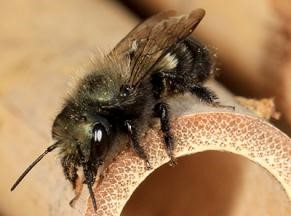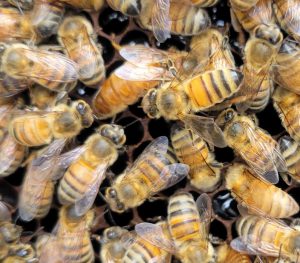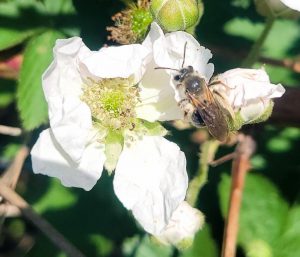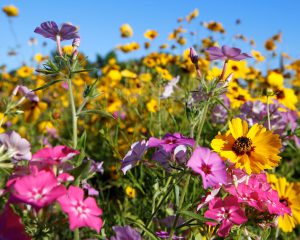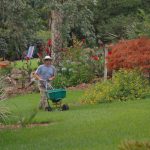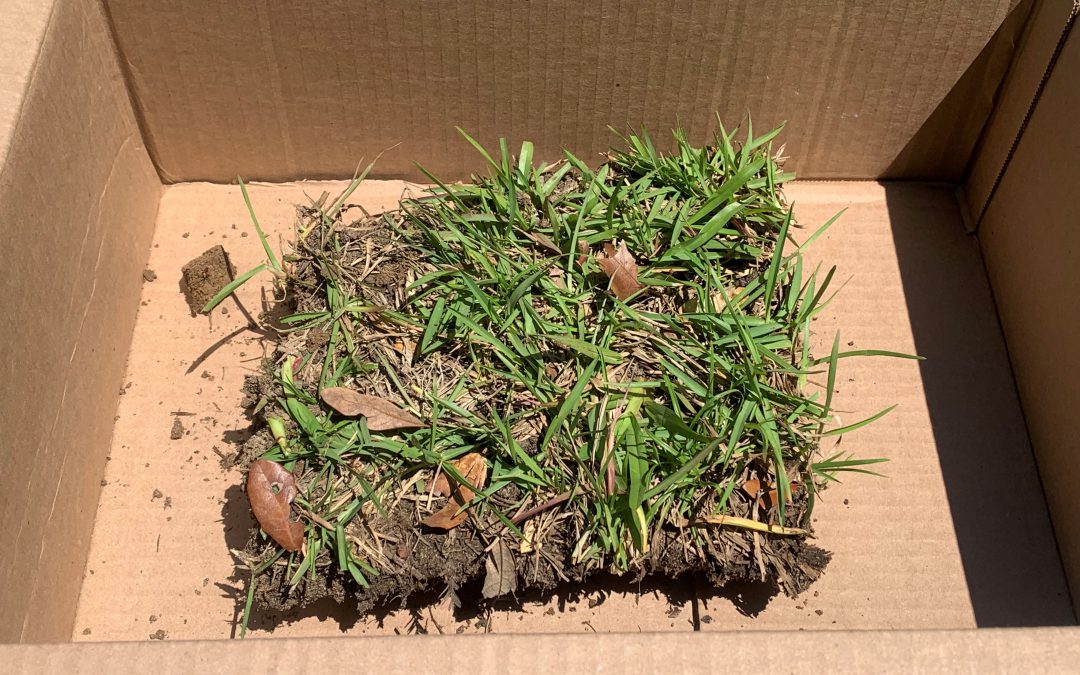

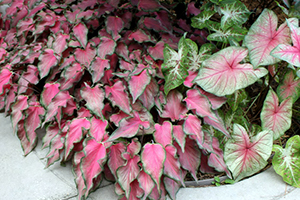
Color All Summer
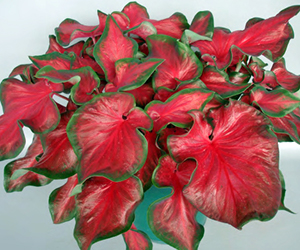 The arrow-shaped leaves of the caladium can add low-maintenance color to the landscape for months. Most effective when massed together in the landscape, caladiums are available in many unique patterns and vibrant colors. A multitude of leaves emerge from a single tuber in various shades of red, white and pink. There are those with spots, ones with bright veins and others with dark green edges. Imagine a pattern, there is probably a caladium to match. Originally discovered in the Amazon River basin, these fast-growing plants can bring life to a shady spot or add drama to the edge of a sunny bed.
The arrow-shaped leaves of the caladium can add low-maintenance color to the landscape for months. Most effective when massed together in the landscape, caladiums are available in many unique patterns and vibrant colors. A multitude of leaves emerge from a single tuber in various shades of red, white and pink. There are those with spots, ones with bright veins and others with dark green edges. Imagine a pattern, there is probably a caladium to match. Originally discovered in the Amazon River basin, these fast-growing plants can bring life to a shady spot or add drama to the edge of a sunny bed.
Caladium plants usually grow 1-2.5 feet high with leaves that measure 6-12 inches in length. Most caladiums thrive in partial shade. But, many new cultivars have been bred to grow in direct sunlight for many hours of the day. Plant breeders, including researchers at the University of Florida, release new cultivars each year. Many of them are patented.
Cultivars are broadly separated into two main categories: fancy and lance-leafed, also referred to as strap-leafed. Fancy-leafed cultivars have large heart-shaped leaves. Lance-leafed cultivars have narrow, elongated leaves. So, when choosing a caladium, there are many decisions to make: sun or shade; short, medium or tall; pattern or solid color; and leaf shape.
Some the traditional fancy-leafed caladium cultivars include: ‘Aaron’, a medium white with a large dark green edge; ‘Carolyn Whorton’, a medium pink blotched leaf; and ‘Postman Joyner’, a medium red with large veins extending into the dark green edge. These are suitable for more sunlight.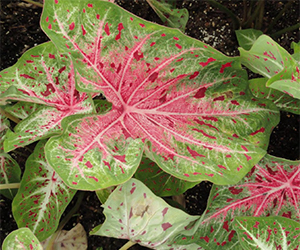
On the extreme other side are the shade-loving speckled strap-leafed cultivars like ‘Miss Muffet’, ‘Gingerland’ and ‘Sea Foam Pink’, a newer UF developed cultivar. For more information on the caladium cultivars developed at UF go to: https://gardeningsolutions.ifas.ufl.edu/plants/ornamentals/caladium-cultivars.html. Keep an eye on children and pets when they are around the caladium plants. The leaves are toxic if ingested.
Plant caladium tubers in spring once the soil is at least 60-70 degrees F. Place them “eye side” up. That is the side that is all lumpy. If you want shorter, compact plants that don’t show as much stem, “de-eye” and dry the tubers for a day before planting them. That means scoop out the peak of the mound. This will force the remaining buds to sprout around it. Place the tubers in the ground 2 inches deep and 8-12 inches apart. Once they have sprouted, apply a light fertilizing once or twice over the summer. Choose a fertilizer that contains a slow-release nitrogen and is low in phosphorus. Excess nutrients will force the leaves to become greener, losing all the unique colors and patterns.
At the end of the season the leaves will decline and go dormant naturally. The tubers can be left in the ground, but if they experience a cold and/or wet winter, expect losses. Digging them will ensure that there will be tubers for next year. The tubers should be dusted with a sulfur fungicide prior to being stored in dry peat moss or vermiculite at temperatures between 50 and 60 degrees F.
 If you want to learn more about caladiums and have an opportunity to purchase the Proven Winner new introductions from 2021 and 2022, join me at the Destin Garden Club meeting on May 10, 2022. The program will be held at the Resurrection Catholic Church, 259 Miramar Beach Dr. Miramar Beach, FL beginning at 9 a.m.
If you want to learn more about caladiums and have an opportunity to purchase the Proven Winner new introductions from 2021 and 2022, join me at the Destin Garden Club meeting on May 10, 2022. The program will be held at the Resurrection Catholic Church, 259 Miramar Beach Dr. Miramar Beach, FL beginning at 9 a.m.
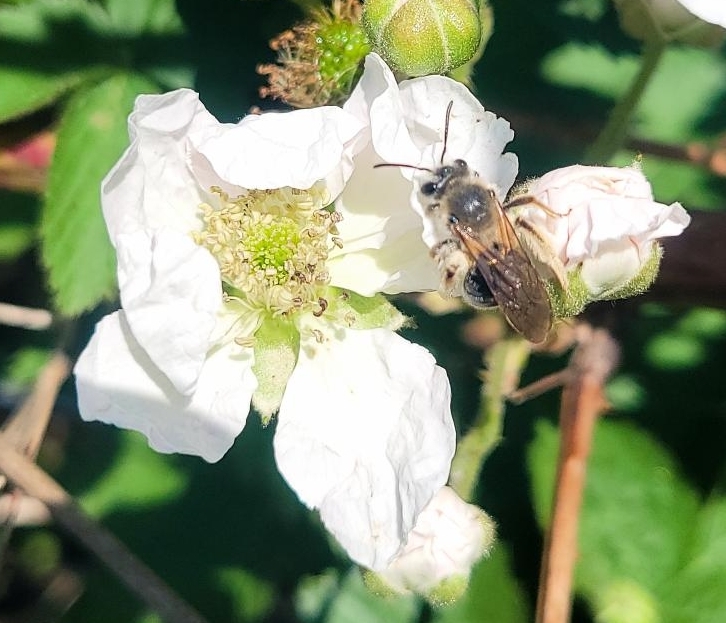
Spring into Action- Pollinators
As spring approaches, are we thinking about pollinators? How often do we stop to think of the importance of pollinators to food security?
Pollination is often described as the transfer of pollen grains from the anther to the stigma of a flowering plant. These transfers are made possible due to pollinator visits in exchange of pollen and nectar from the plants.
Who are our pollinators?
Main Global Pollinators
Social Solitary
Honeybees Alfalfa leafcutter bee
Bumble bees Mason bees
Stingless bees Other leafcutter bees
How can we care for pollinators?
We can care for our pollinators by growing plants that have abundant and accessible pollen and nectar.
Choose plants with flat flowers or short to medium-length flowers tubes (corollas), and limit plants with long flower tubes such as honey suckle.
Avoid plant varieties that do not provide floral rewards (pollen), which is the essential food source for bees. (e.g., some sunflower, and lilies).
Many native wild bees have relatively short proboscises, or tongues, and may not be able to access nectar from flowers with long tubes; however, flowers with long floral tubes can attract other pollinators with long tongues or beaks such as butterflies, moths, and hummingbirds.
Are we creating an ecosystem aesthetically pleasing while attracting pollinators?
The planting of native wildflower in Florida can benefit agricultural producers likewise, native pollinators and other beneficials such as parasitoids and predators. Some of the main benefits of growing native wildflower are:
- Increasing wild bee presence in the surroundings.
- Providing nesting and foraging sites for pollinators, butterflies, bees etc.
- Increasing natural enemies of pest insects.
It is important to select mix varieties of native wildflower when restoring habitats for our pollinators. Mix varieties will flower all year round and make available continuous supply of nectar and pollen. If possible, use wildflower seeds that are produced in the state that you want to carry out pollinators’ restoration. It is highly likely that one will experience better growth from locally produced seeds because they will adapt better to regional growing conditions and the climate. For optimum flowering and high production of floral rewards such as pollen and nectar. Place wildflowers in areas free of pesticide and soil disturbance.
Most bee species are solitary, and 70% of these solitary bees’ nest in the ground. A wildflower area of refuge can fulfill the shelter resource needs of these bees since that area will not undergo regular tilling, thus minimizing nest disturbance.
Supporting information for this article can be found in the UF/IFAS EDIS publications (Common Native Wildflowers of North Florida) visit : https://edis.ifas.ufl.edu/pdf/EP/EP061/EP061-15448828.pdf and Attracting Native Bees to Your Florida Landscape IN125500.pdf (ufl.edu.
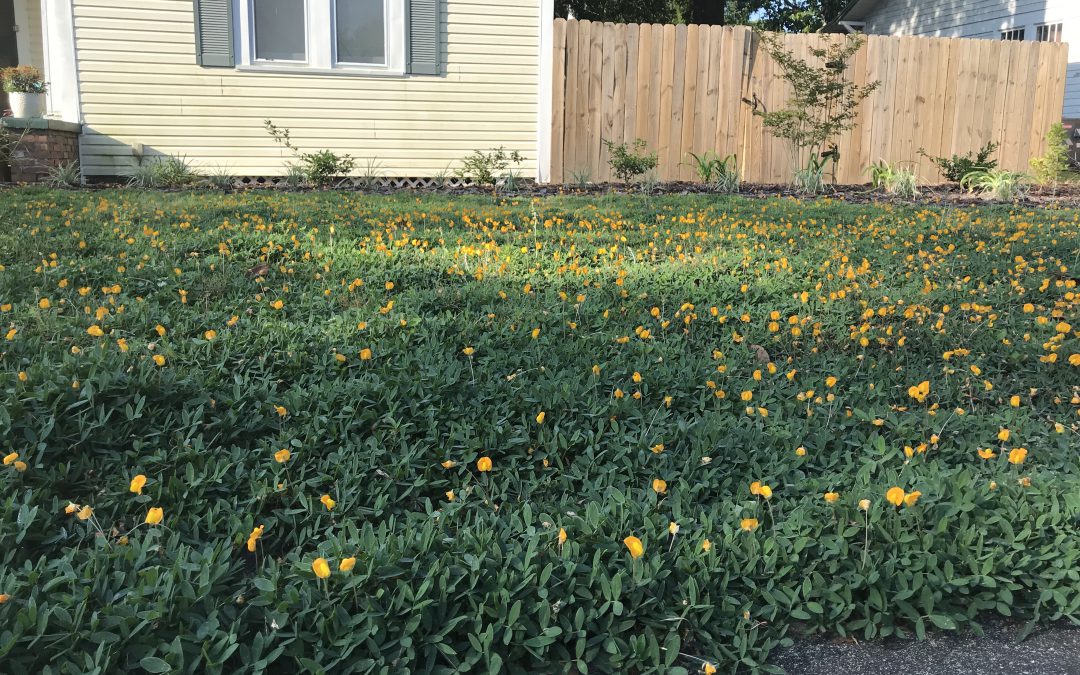
Gardening in the Panhandle LIVE Program Summary: Turfgrass & Groundcovers
Turf lawns provide an excellent groundcover that hold soil in place, filter pollutants, and are beautiful. However, turfgrass may not be your first groundcover choice, due to heavy shade, landscape layout, or just personal preference. In that case, there are a lot of alternative groundcovers on the market. To help determine what groundcovers do best under certain conditions and to provide information on lawncare and groundcover maintenance, this month’s Gardening in the Panhandle LIVE! was all about groundcovers.
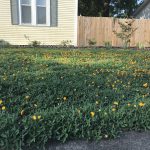
‘Needlepoint’ Perennial Peanut in a yard. Photo Credit: Daniel Leonard, University of Florida/IFAS Extension – Calhoun County
Turfgrass/Groundcover Selection
The University of Florida/IFAS has a long list of publications on alternatives to turfgrass. The comprehensive list can be found at Ask IFAS: Groundcovers.
One of the groundcovers that does well in full sun and has beautiful yellow flowers is perennial peanut. More information on perennial peanut can be found in the publication “Guide to Using Rhizomal Perennial Peanut in the Urban Landscape”.
Groundcover options for the shade include Algerian ivy, Asiatic jasmine, and mondo grass. Read more about these and other shade friendly species at “Gardening Solutions: Groundcovers for the Shade”.
Frogfruit can tolerate full sun and partial shade.
You could also create a wildflower meadow in a sunny spot. More wildflower information is available at Ask IFAS: Performance of Native Florida Plants Under North Florida Conditions.
White clover is a groundcover that may be best suited in a mix with other groundcover species. The publication “White Clover” provides some excellent information on growing this plant.
A number of factors come into play when you are choosing a turfgrass species. Some species are more tolerant of shade than others and maintenance levels are species and variety specific. The “Choosing Grass for Your Lawn” webpages can help answer some common questions. For additional information on turfgrass species a list of EDIS publications and other UF/IFAS websites is available at Ask IFAS: Your Florida Lawn. (Note: Buffalograss is not recommended for Florida.)
Overseeding is not a recommended practice for home lawns, but information is available at the webpage “Overseed Florida Lawns for Winter Color”.
Management of Turf and Groundcovers
Turfgrass requires the right amount of care. To help maintain a good looking yard, follow the management practices in the publication “Homeowner Best Management Practices for the Home Lawn”.
A soil sample is a good place to start to determine the root of the issues you may have in your lawn. Follow these simple steps to collect and submit a sample for accurate analysis.
Weed management can be difficult in turf and other groundcovers. Cultural, mechanical, and chemical controls can help keep weeds under control. The “Weed Management Guide for Florida Lawns” provides control options for the majority of weeds you’ll encounter in your lawn. More information on weed control in turf alternatives can be found in the publication “Improving Weed Control in Landscape Beds”.
Virginia buttonweed is a common weed that is often difficult to control. Doveweed can also be difficult to control.
The publication “Adopting a Florida Friendly Landscape” outlines the nine principals to help you design, install, and maintain a landscape that will thrive in our climate.
Fertilizer is required to maintain a healthy lawn. A list of lawn fertilization publications and links can be found at Ask IFAS: Lawn Fertilizer.
Lawns in the southeast are susceptible to a number of different diseases mostly thanks to our hot and humid weather. But there are some preventative and curative practices you can implement to help keep disease under control. The “Turfgrass Disease Management” publication answers a lot of questions about disease control.
Past episodes of Gardening in the Panhandle LIVE can be found on our YouTube playlist.
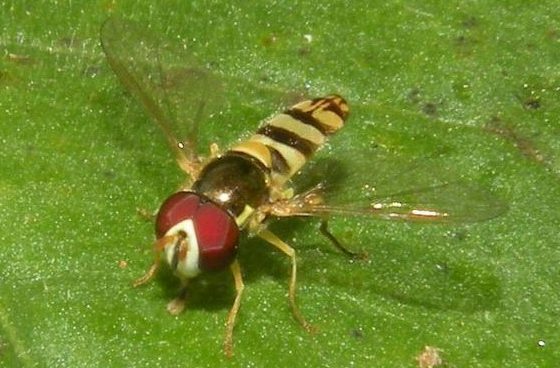
The Flower Power of Garden Flies
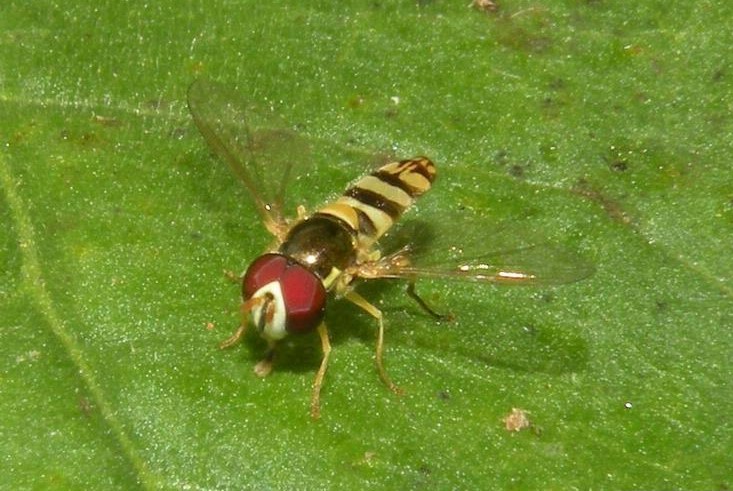
While we think of most flies as pests, garden flies, such as Allograpta obliqua species found in Florida, are excellent pollinators and predators of insects. Photo by Jessica Louque, Smithers Viscient, Bugwood.org.
While our sentiments toward flies usually involve fly swatters, believe it or not, not all flies are nuisance pests! Some types of flies can actually be quite helpful in the garden.
These garden flies are nothing like your typical pesky house fly. While house flies and garden flies are both insects in the order Diptera, they are not in the same insect family, which is the next classification down in Linnaean taxonomy.
The nectar-loving garden flies that specifically visit flowers are in the family Syrphidae and are known as Syrphid flies, hoverflies, or flower flies. Although not as well-known in the pollinating world, there are almost 900 species of flower flies in North America, and they can be very colorful and eye-catching in the garden.
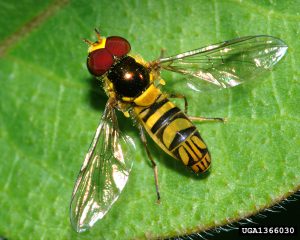
Allograpta obliqua flower fly adults are small and have bright yellow and black crossbands on their abdomens. Photo by Susan Ellis, Bugwood.org.
One of the most common flower flies in Florida is the species Allograpta obliqua. Members of this species, also called hoverflies, are often mistaken as fruit flies, and can therefore be perceived as harmful. But to the contrary, adults cross pollinate many flowers, and hoverfly larvae feed on predators, such as aphids that attack vegetables, fruit trees, cotton, ornamentals, and many wild plants. In fact, when there are numerous hoverfly larvae present, they can reduce aphid infestations by 70 to 100 percent!
Allograpta obliqua adults can be hard to spot, as they are a mere six-to-seven millimeters in length. Although small, they have distinct bright-yellow and black crossbands on their abdomen and become particularly abundant in the spring and summer here in the Florida Panhandle.
So, before you go swatting at any ole fly you see, remember that flower flies are our allies in the garden. Adults will aid in the pollination of our crops and landscape plants, and larvae will help defend our spring and summer veggies from the devastation of harmful insect attacks.
Learn more about Allograpta obliqua hoverfly species at the UF/IFAS Featured Creatures website (https://entnemdept.ufl.edu/creatures/beneficial/hover_fly.htm).

